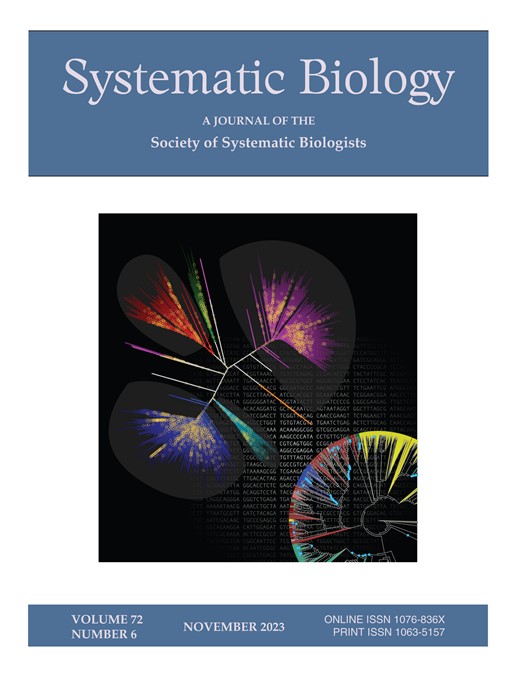On the Mkv Model with Among-Character Rate Variation
IF 6.1
1区 生物学
Q1 EVOLUTIONARY BIOLOGY
引用次数: 0
Abstract
Models used in likelihood-based morphological phylogenetics often adapt molecular phylogenetics models to the specificities of morphological data. Such is the case for the widely used Mkv model—which introduces an acquisition bias correction for sampling only characters that are observed to be variable—and for models of among-character rate variation (ACRV), routinely applied by researchers to relax the equal-rates assumption of Mkv. However, the interaction between variable character acquisition bias and ACRV has never been explored before. We demonstrate that there are two distinct approaches to condition the likelihood on variable characters when there is ACRV, and we call them joint and marginal acquisition bias. Far from being just a trivial mathematical detail, we show that the way in which the variable character conditional likelihood is calculated results in different assumptions about how rate variation is distributed in morphological datasets. Simulations demonstrate that tree length and amount of ACRV in the data are systematically biased when conditioning on variable characters differently from how the data was simulated. Moreover, an empirical case study with extant and extinct taxa reveals a potential impact not only on the estimation of branch lengths, but also of phylogenetic relationships. We recommend the use of the marginal acquisition bias approach for morphological datasets modeled with ACRV. Finally, we urge developers of phylogenetic software to clarify which acquisition bias correction is implemented for both estimation and simulation, and we discuss the implications of our findings on modeling variable characters for the future of morphological phylogenetics.特征间速率变化的Mkv模型
在基于似然的形态系统发育中使用的模型经常使分子系统发育模型适应形态数据的特殊性。这就是广泛使用的Mkv模型的情况——它引入了采集偏差校正,只采样被观察到是可变的字符——以及字符间速率变化模型(ACRV),研究人员经常使用它来放宽Mkv的等速率假设。然而,可变字符习得偏差与ACRV之间的相互作用尚未得到研究。我们证明,当存在ACRV时,有两种不同的方法来限定可变字符的可能性,我们称之为联合获取偏差和边际获取偏差。这不仅仅是一个微不足道的数学细节,我们还表明,计算可变字符条件似然的方式会导致关于形态学数据集中速率变化如何分布的不同假设。模拟结果表明,当对变量特征的调节与模拟数据不同时,数据中ACRV的树长度和数量会有系统的偏差。此外,对现存和灭绝的分类群的实证研究表明,这不仅对分支长度的估计有潜在的影响,而且对系统发育关系的估计也有潜在的影响。我们建议对ACRV建模的形态学数据集使用边际获取偏差方法。最后,我们敦促系统发育软件的开发人员澄清在估计和模拟中实现了哪些获取偏差校正,并讨论了我们的发现对形态系统发育未来的可变特征建模的影响。
本文章由计算机程序翻译,如有差异,请以英文原文为准。
求助全文
约1分钟内获得全文
求助全文
来源期刊

Systematic Biology
生物-进化生物学
CiteScore
13.00
自引率
7.70%
发文量
70
审稿时长
6-12 weeks
期刊介绍:
Systematic Biology is the bimonthly journal of the Society of Systematic Biologists. Papers for the journal are original contributions to the theory, principles, and methods of systematics as well as phylogeny, evolution, morphology, biogeography, paleontology, genetics, and the classification of all living things. A Points of View section offers a forum for discussion, while book reviews and announcements of general interest are also featured.
 求助内容:
求助内容: 应助结果提醒方式:
应助结果提醒方式:


